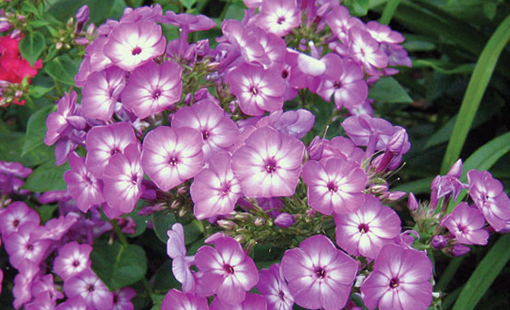
All About Phlox
Phlox are perennials and a favorite choice—from ground cover that blooms in early spring to the tall phlox that bloom in mid- to late summer. Learn more about how to grow and care for the phlox in your garden!
About Phlox
These plants sport many star-shaped, colorful flowers when in bloom. Because there are so many varieties and types (many of which are native to North America), you can find a phlox for almost any garden. Truly, their versatility can’t be overstated.
- Low-growing or creeping phlox work great as ground cover.
- Tall phlox are excellent as a colorful backdrop.
- Medium-height varieties can fill in any gaps!
Plus, phlox are low maintenance and have a lovely fragrance.
Planting
Because there are so many different types of phlox, sunlight requirements vary. Tall garden phlox do best in full sun, while woodland species thrive in partial shade.
In general, phlox prefer soil that is nutrient rich and evenly moist. They do not like to sit in wet soil, however. Use a garden fork or tiller to prepare your garden bed prior to planting. Loosen the soil to about 12 to 15 inches deep, then mix in a 2- to 4-inch layer of compost to improve soil consistency and fertility.
When to Plant
Plant phlox in the spring after the threat of frost has passed, or plant in the fall, at least a month before your first frost.
How to Plant
- It is easier to grow phlox from cuttings/transplants than from seeds, although established plants will readily spread by seed in the garden.
- Space plants according to their mature size.
- If you are transplanting a plant from a pot, dig a hole about twice the size of the pot’s diameter and place the plant so that the top of the root ball is even with the soil’s surface. Fill in around the root ball and remember to water it thoroughly.
Growing
- If you receive less than 1 inch of rain a week, remember to regularly water your plants throughout the summer.
- Each spring, put a thin layer of compost and a 2-inch layer of mulch around the plants to help keep the soil moist and control weeds.
- Remember to remove the dead/faded flowers so that your plants can rebloom.
- If you have tall phlox, cut the stems back to about 1 to 2 inches above the soil after the first killing frost in the fall. Divide tall garden phlox every 2 to 3 years to ensure healthy and disease-free plants.
Recommended Varieties
You just can’t go wrong with phlox! Here are some of the best species and varieties to try:
Low-Growing Phlox
Creeping phlox or moss phlox is a low-growing species that works excellently as a ground cover. It spreads slowly, growing in mounds that get 4–6 inches thick. The whole plant turns into a carpet of color in spring, when flowers cover every square inch of foliage. This phlox is particularly stunning when allowed to drape over a rock wall—imagine a waterfall of color! Creeping phlox grows best in well-drained soil and partial to full sun.
Woodland phlox or blue phlox is another low-growing species. As its two common names suggest, it prefers partial to full shade and moist, rich soils, and produces bluish flowers in early spring. Its flowers bloom on stems that rise about a foot or so above the creeping foliage.
Medium-Height Phlox
Annual phlox or Drummond’s phlox grows as an annual rather than a perennial, unlike most other phlox species. Annual phlox rarely grows taller than 2 feet in height. Most varieties are not very heat tolerant, but in warmer regions you may find the heat-tolerant varieties for sale. Plant in well-draining soil in a site that gets partial sun and doesn’t stay too wet.
Tall Phlox
Garden phlox or summer phlox is the tallest phlox in cultivation and is probably the species that most folks have in their gardens. It grows in clumps that reach between 3 and 5 feet in height and produces panicles of flowers in mid- to late summer. Though tolerant of most lighting, it grows and flowers best in partial to full sun. It has a reputation for being very susceptible to powdery mildew, but resistant varieties are available.
Fun Facts
April’s full Moon has traditionally been called the “Full Pink Moon” because it heralded the appearance of the “moss pink,” or wild ground phlox—one of the first spring flowers.
Common Pests & Diseases
- Powdery mildew is common; keep proper air circulation in mind when spacing out plants and avoid getting excess water on the foliage. Cutting back stems after flowering can also help to reduce the spread of powdery mildew, as can choosing mildew-resistant varieties.
- Stem canker
- Rust
- Southern blight
- Stem nematodes
- Leaf spots
- Leaf miners
- Caterpillars
Information courtesy of Almanac.com

 Adams Fairacre Farms
Adams Fairacre Farms